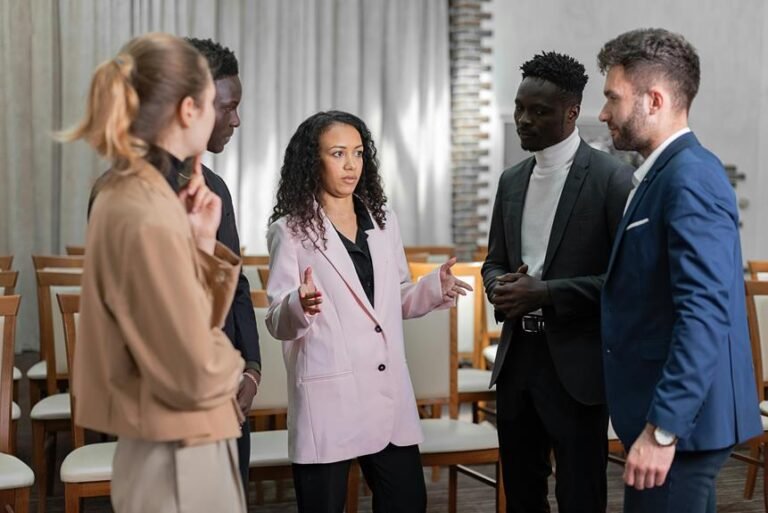Improving Communication After a Fight

Improving Communication After a FightAfter a fight, understanding emotional triggers like feeling unheard or criticized is key. Practice active listening by focusing on your partner’s words and using reflective techniques. Set boundaries and show mutual respect for healthier communication. Express vulnerability and empathy to deepen connections. Stay calm and patient to avoid impulsive reactions. Use ‘I’ statements to express feelings clearly. Seek compromises and solutions together by brainstorming and staying open-minded. Rebuilding trust involves understanding each other’s emotions without judgment. Each step can help you improve communication after a fight and reconnect on a deeper level for better understanding and resolution.
Key Takeaways
- Practice active listening to understand emotions.
- Use ‘I’ statements to express feelings effectively.
- Seek compromise and solutions through open communication.
- Set boundaries and show respect for each other.
- Rebuild trust by acknowledging emotions and perspectives.
Understanding Emotional Triggers
When tensions rise during a disagreement, understanding the emotional triggers that can fuel the conflict is essential. Identifying triggers is like shining a light on the underlying reasons why a disagreement escalated into a full-blown fight.
Take a moment to reflect on your emotional responses during past conflicts. Were there specific words, actions, or situations that seemed to push your buttons? These triggers can vary from person to person, but common ones include feeling unheard, criticized, or dismissed.
By recognizing these triggers, you can start to gain insight into your own emotional reactions. Perhaps you noticed that you tend to get defensive when your opinions are challenged or that you feel abandoned when your partner walks away during an argument.
Understanding these triggers can help you communicate your needs more effectively and approach conflicts with a calmer mindset.
Active Listening Techniques
Understanding emotional triggers can pave the way for improved communication, especially when it comes to implementing active listening techniques.
When engaging in a conversation after a disagreement, it’s vital to practice reflective listening. This means truly focusing on what your partner is saying without interrupting, and then paraphrasing it back to them to show you understand. Pay attention to nonverbal cues as well; often, emotions can be conveyed more accurately through body language than words.
Mirroring feelings is another effective technique. Try to put yourself in your partner’s shoes and reflect back the emotions they’re expressing. This can help them feel heard and validated.
Additionally, using open-ended questions can encourage your partner to share more about their feelings and perspective. Instead of asking yes or no questions, try to prompt deeper discussions by asking questions that require more elaborate answers.
Setting Boundaries and Respect
To nurture a healthier and more respectful communication dynamic, it’s vital to establish clear boundaries and guarantee mutual respect in your interactions. Boundaries serve as guidelines that outline what’s acceptable behavior and what’s not, creating a safe space for both parties to express themselves freely.
When setting boundaries, communicate them openly and assertively, making sure to listen to and respect the boundaries set by the other person as well.
Respect is the cornerstone of any successful relationship. Showing respect involves actively listening, being mindful of your words and actions, and acknowledging the other person’s feelings and perspectives.
Expressing Vulnerability and Empathy
Demonstrating vulnerability and empathy in your communication allows for a deeper connection and understanding between you and the other person. When you show compassion and understanding, you create a safe space for open dialogue and emotional honesty. Expressing vulnerability involves sharing your thoughts and feelings openly, even if they make you feel exposed. By doing so, you invite the other person to do the same, fostering a sense of intimacy and trust.
Empathy plays an essential role in this process. It involves actively listening to the other person’s perspective, acknowledging their emotions, and validating their experiences. When you show empathy, you demonstrate that you care about the other person’s feelings and are willing to understand their point of view. This not only strengthens your bond but also paves the way for more meaningful conversations in the future.
Incorporating vulnerability and empathy into your communication can lead to greater connection and intimacy, helping you navigate conflicts with understanding and compassion.
Practicing Patience and Calmness
Maintaining a sense of patience and calmness during a discussion can greatly influence the outcome and quality of communication. When emotions run high, it’s easy to react impulsively and say things we might regret later.
Instead, try incorporating deep breathing and mindfulness techniques into your routine.
In moments of tension, take a deep breath in, hold it for a few seconds, and then exhale slowly. This simple act can help regulate your emotions and bring a sense of calmness to the situation.
Using “I” Statements Effectively
Using ‘I’ statements effectively can be a powerful tool in resolving conflicts and improving communication with others. When you express yourself assertively using ‘I’ statements, you take ownership of your feelings and thoughts, which can help prevent misunderstandings and defensiveness in conversations. Instead of pointing fingers or placing blame, focus on describing your emotions and experiences using phrases like ‘I feel’ or ‘I need.’
This approach allows you to communicate your perspective in a way that’s clear and non-confrontational.
Effective communication isn’t just about conveying your message but also about creating a space for open dialogue and understanding. By using ‘I’ statements, you invite the other person to engage in a more empathetic and constructive conversation. This method encourages active listening and promotes mutual respect in the exchange of ideas.
In moments of tension or disagreement, remember that assertive expression through ‘I’ statements can foster a sense of connection and collaboration, paving the way for healthier resolutions and strengthened relationships.
Seeking Compromise and Solutions
When dealing with conflicts, actively seeking compromise and solutions that address the needs of all parties involved is vital. Compromise resolution requires a willingness to listen, understand, and find common ground. It’s crucial to approach the situation with an open mind and a genuine desire to reach a resolution that respects everyone’s feelings and perspectives.
Finding solutions often involves brainstorming together to come up with innovative ideas that meet each other’s needs halfway. Remember, it’s not about winning or losing but about coming to a mutual agreement that benefits the relationship as a whole.
Communication plays a significant role in this process – be transparent about your feelings, listen attentively to the other person’s concerns, and work together to find a solution that satisfies both parties.
Rebuilding Trust and Connection
To rebuild trust and connection after a conflict, focusing on understanding each other’s emotions and perspectives is essential.
When working towards rebuilding rapport and strengthening bonds, it’s vital to create a safe space where both parties feel heard and validated.
Take the time to listen actively without judgment, allowing each other to express their feelings openly.
Acknowledging the pain or frustration that was experienced during the conflict can pave the way for fostering reconciliation and enhancing communication.
Frequently Asked Questions
How Can I Prevent the Same Conflict From Happening Again?
To prevent the same conflict from happening again, actively listen to each other’s perspectives, reflect on feelings, and set clear boundaries. Compromise when needed, prioritize understanding, and communicate openly to foster a stronger, more resilient relationship.
Should I Apologize First Even if I Feel I’m Not at Fault?
Apologize first, even if feeling blameless, shows maturity and prioritizes relationship over ego. Taking responsibility builds trust. Acknowledge emotions, understand perspectives. It’s about connection and growth, not winning arguments.
Can Non-Verbal Communication Impact Post-Fight Discussions?
Body language and tone of voice play pivotal roles in post-fight discussions. They can convey emotions and intentions even without words. Being aware of your non-verbal cues can help foster understanding and connection after a conflict.
Is It Beneficial to Involve a Third Party in Resolving Conflicts?
Involving a third party, like a mediator, can be highly beneficial in resolving conflicts. They offer a neutral perspective, guiding discussions with effectiveness. Their presence often helps both parties communicate more openly and find common ground.
How Do I Address Unresolved Issues From Past Arguments?
Address unresolved issues by actively listening to each other’s perspectives with empathy. Show emotional intelligence by acknowledging and validating feelings. Work together to find resolution through open communication and a genuine desire to understand each other.
Conclusion
To sum up, remember that communication after a fight takes effort from both parties. By understanding emotional triggers, actively listening, setting boundaries, expressing vulnerability, and practicing patience, you can rebuild trust and connection.
Use ‘I’ statements effectively, seek compromise, and be open to solutions. With time and effort, you can improve your communication and strengthen your relationship.
Remember, it’s okay to take a step back and reassess, but always come back to the table with an open heart and mind.






